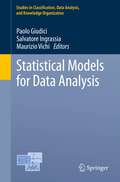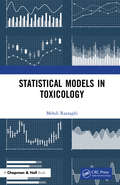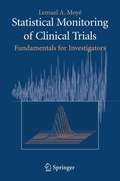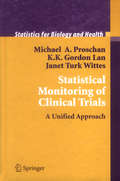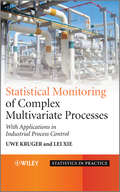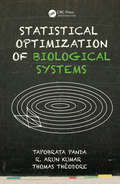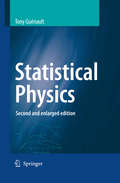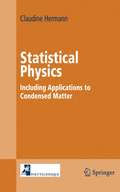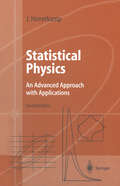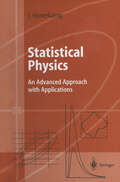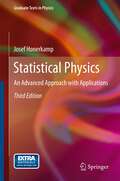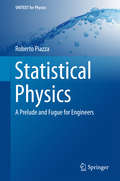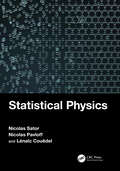- Table View
- List View
Statistical Models for Causal Analysis
by Robert D. Retherford Minja Kim ChoeSimplifies the treatment of statistical inference focusing on how to specify and interpret models in the context of testing causal theories. Simple bivariate regression, multiple regression, multiple classification analysis, path analysis, logit regression, multinomial logit regression and survival models are among the subjects covered. Features an appendix of computer programs (for major statistical packages) that are used to generate illustrative examples contained in the chapters.
Statistical Models for Data Analysis (Studies in Classification, Data Analysis, and Knowledge Organization)
by Paolo Giudici, Salvatore Ingrassia and Maurizio VichiThe papers in this book cover issues related to the development of novel statistical models for the analysis of data. They offer solutions for relevant problems in statistical data analysis and contain the explicit derivation of the proposed models as well as their implementation. The book assembles the selected and refereed proceedings of the biannual conference of the Italian Classification and Data Analysis Group (CLADAG), a section of the Italian Statistical Society.
Statistical Models for Proportions and Probabilities (SpringerBriefs in Statistics)
by George A.F. SeberMethods for making inferences from data about one or more probabilities and proportions are a fundamental part of a statistician’s toolbox and statistics courses. Unfortunately many of the quick, approximate methods currently taught have recently been found to be inappropriate. This monograph gives an up-to-date review of recent research on the topic and presents both exact methods and helpful approximations. Detailed theory is also presented for the different distributions involved, and can be used in a classroom setting. It will be useful for those teaching statistics at university level and for those involved in statistical consulting.
Statistical Models for Test Equating, Scaling, and Linking (Statistics for Social and Behavioral Sciences)
by Alina A. DavierThe goal of this book is to emphasize the formal statistical features of the practice of equating, linking, and scaling. The book encourages the view and discusses the quality of the equating results from the statistical perspective (new models, robustness, fit, testing hypotheses, statistical monitoring) as opposed to placing the focus on the policy and the implications, which although very important, represent a different side of the equating practice. The book contributes to establishing “equating” as a theoretical field, a view that has not been offered often before. The tradition in the practice of equating has been to present the knowledge and skills needed as a craft, which implies that only with years of experience under the guidance of a knowledgeable practitioner could one acquire the required skills. This book challenges this view by indicating how a good equating framework, a sound understanding of the assumptions that underlie the psychometric models, and the use of statistical tests and statistical process control tools can help the practitioner navigate the difficult decisions in choosing the final equating function. This book provides a valuable reference for several groups: (a) statisticians and psychometricians interested in the theory behind equating methods, in the use of model-based statistical methods for data smoothing, and in the evaluation of the equating results in applied work; (b) practitioners who need to equate tests, including those with these responsibilities in testing companies, state testing agencies, and school districts; and (c) instructors in psychometric, measurement, and psychology programs.
Statistical Models in Epidemiology, the Environment, and Clinical Trials (The IMA Volumes in Mathematics and its Applications #116)
by M. Elizabeth Halloran Donald BerryThis IMA Volume in Mathematics and its Applications STATISTICAL MODELS IN EPIDEMIOLOGY, THE ENVIRONMENT,AND CLINICAL TRIALS is a combined proceedings on "Design and Analysis of Clinical Trials" and "Statistics and Epidemiology: Environment and Health. " This volume is the third series based on the proceedings of a very successful 1997 IMA Summer Program on "Statistics in the Health Sciences. " I would like to thank the organizers: M. Elizabeth Halloran of Emory University (Biostatistics) and Donald A. Berry of Duke University (Insti tute of Statistics and Decision Sciences and Cancer Center Biostatistics) for their excellent work as organizers of the meeting and for editing the proceedings. I am grateful to Seymour Geisser of University of Minnesota (Statistics), Patricia Grambsch, University of Minnesota (Biostatistics); Joel Greenhouse, Carnegie Mellon University (Statistics); Nicholas Lange, Harvard Medical School (Brain Imaging Center, McLean Hospital); Barry Margolin, University of North Carolina-Chapel Hill (Biostatistics); Sandy Weisberg, University of Minnesota (Statistics); Scott Zeger, Johns Hop kins University (Biostatistics); and Marvin Zelen, Harvard School of Public Health (Biostatistics) for organizing the six weeks summer program. I also take this opportunity to thank the National Science Foundation (NSF) and the Army Research Office (ARO), whose financial support made the workshop possible. Willard Miller, Jr.
Statistical Models in S
by T. J. HastieStatistical Models in S extends the S language to fit and analyze a variety of statistical models, including analysis of variance, generalized linear models, additive models, local regression, and tree-based models. The contributions of the ten authors-most of whom work in the statistics research department at AT&T Bell Laboratories-represent results of research in both the computational and statistical aspects of modeling data.
Statistical Models in S
by John M. Chambers and Trevor J. HastieStatistical Models in S extends the S language to fit and analyze a variety of statistical models, including analysis of variance, generalized linear models, additive models, local regression, and tree-based models. The contributions of the ten authors-most of whom work in the statistics research department at AT&T Bell Laboratories-represent results of research in both the computational and statistical aspects of modeling data.
Statistical Models in Toxicology
by Mehdi RazzaghiStatistical Models in Toxicology presents an up-to-date and comprehensive account of mathematical statistics problems that occur in toxicology. This is as an exciting time in toxicology because of the attention given by statisticians to the problem of estimating the human health risk for environmental and occupational exposures. The development of modern statistical techniques with solid mathematical foundations in the 20th century and the advent of modern computers in the latter part of the century gave way to development of many statistical models and methods to describe toxicological processes and attempts to solve the associated problems. Not only have the models enjoyed a high level of elegance and sophistication mathematically, they are widely used by industry and government regulatory agencies. Features: Focuses on describing the statistical models in environmental toxicology that facilitate the assessment of risk mainly in humans. The properties and shortfalls of each model are discussed and its impact in the process of risk assessment is examined. Discusses models that assess the risk of mixtures of chemicals. Presents statistical models that are developed for risk estimation in different aspects of environmental toxicology including cancer and carcinogenic substances. Includes models for developmental and reproductive toxicity risk assessment, risk assessment in continuous outcomes and developmental neurotoxicity. Contains numerous examples and exercises. Statistical Models in Toxicology introduces a wide variety of statistical models that are currently utilized for dose-response modeling and risk analysis. These models are often developed based on design and regulatory guidelines of toxicological experiments. The book is suitable for practitioners or as use as a textbook for advanced undergraduate or graduate students of mathematics and statistics.
Statistical Models in Toxicology
by Mehdi RazzaghiStatistical Models in Toxicology presents an up-to-date and comprehensive account of mathematical statistics problems that occur in toxicology. This is as an exciting time in toxicology because of the attention given by statisticians to the problem of estimating the human health risk for environmental and occupational exposures. The development of modern statistical techniques with solid mathematical foundations in the 20th century and the advent of modern computers in the latter part of the century gave way to development of many statistical models and methods to describe toxicological processes and attempts to solve the associated problems. Not only have the models enjoyed a high level of elegance and sophistication mathematically, they are widely used by industry and government regulatory agencies. Features: Focuses on describing the statistical models in environmental toxicology that facilitate the assessment of risk mainly in humans. The properties and shortfalls of each model are discussed and its impact in the process of risk assessment is examined. Discusses models that assess the risk of mixtures of chemicals. Presents statistical models that are developed for risk estimation in different aspects of environmental toxicology including cancer and carcinogenic substances. Includes models for developmental and reproductive toxicity risk assessment, risk assessment in continuous outcomes and developmental neurotoxicity. Contains numerous examples and exercises. Statistical Models in Toxicology introduces a wide variety of statistical models that are currently utilized for dose-response modeling and risk analysis. These models are often developed based on design and regulatory guidelines of toxicological experiments. The book is suitable for practitioners or as use as a textbook for advanced undergraduate or graduate students of mathematics and statistics.
Statistical Monitoring of Clinical Trials: Fundamentals for Investigators
by Lemuel A. MoyéStatistical Monitoring of Clinical Trials: Fundamentals for Investigators introduces the investigator and statistician to monitoring procedures in clinical research. Clearly presenting the necessary background with limited use of mathematics, this book increases the knowledge, experience, and intuition of investigations in the use of these important procedures now required by the many clinical research efforts. The author provides motivated clinical investigators the background, correct use, and interpretation of these monitoring procedures at an elementary statistical level. He defines terms commonly used such as group sequential procedures and stochastic curtailment in non-mathematical language and discusses the commonly used procedures of Pocock, O’Brien–Fleming, and Lan–DeMets. He discusses the notions of conditional power, monitoring for safety and futility, and monitoring multiple endpoints in the study. The use of monitoring clinical trials is introduced in the context of the evolution of clinical research and one chapter is devoted to the more recent Bayesian procedures. From the reviews: "The author has a wealth of experience in this area and this is demonstrated throughout the text with relevant poignant examples." Short Book Reviews of the ISI, June 2006
Statistical Monitoring of Clinical Trials: A Unified Approach (Statistics for Biology and Health)
by Michael A. Proschan K. K. Lan Janet Turk WittesThe approach taken in this book is, to studies monitored over time, what the Central Limit Theorem is to studies with only one analysis. Just as the Central Limit Theorem shows that test statistics involving very different types of clinical trial outcomes are asymptotically normal, this book shows that the joint distribution of the test statistics at different analysis times is asymptotically multivariate normal with the correlation structure of Brownian motion ("the B-value") – irrespective of the test statistic. Thus, this book offers statisticians an accessible, incremental approach to understanding Brownian motion as related to clinical trials.
Statistical Monitoring of Complex Multivatiate Processes: With Applications in Industrial Process Control (Statistics in Practice #135)
by Uwe Kruger Lei XieThe development and application of multivariate statistical techniques in process monitoring has gained substantial interest over the past two decades in academia and industry alike. Initially developed for monitoring and fault diagnosis in complex systems, such techniques have been refined and applied in various engineering areas, for example mechanical and manufacturing, chemical, electrical and electronic, and power engineering. The recipe for the tremendous interest in multivariate statistical techniques lies in its simplicity and adaptability for developing monitoring applications. In contrast, competitive model, signal or knowledge based techniques showed their potential only whenever cost-benefit economics have justified the required effort in developing applications. Statistical Monitoring of Complex Multivariate Processes presents recent advances in statistics based process monitoring, explaining how these processes can now be used in areas such as mechanical and manufacturing engineering for example, in addition to the traditional chemical industry. This book: Contains a detailed theoretical background of the component technology. Brings together a large body of work to address the field’s drawbacks, and develops methods for their improvement. Details cross-disciplinary utilization, exemplified by examples in chemical, mechanical and manufacturing engineering. Presents real life industrial applications, outlining deficiencies in the methodology and how to address them. Includes numerous examples, tutorial questions and homework assignments in the form of individual and team-based projects, to enhance the learning experience. Features a supplementary website including Matlab algorithms and data sets. This book provides a timely reference text to the rapidly evolving area of multivariate statistical analysis for academics, advanced level students, and practitioners alike.
Statistical Monitoring of Complex Multivatiate Processes: With Applications in Industrial Process Control (Statistics in Practice)
by Uwe Kruger Lei XieThe development and application of multivariate statistical techniques in process monitoring has gained substantial interest over the past two decades in academia and industry alike. Initially developed for monitoring and fault diagnosis in complex systems, such techniques have been refined and applied in various engineering areas, for example mechanical and manufacturing, chemical, electrical and electronic, and power engineering. The recipe for the tremendous interest in multivariate statistical techniques lies in its simplicity and adaptability for developing monitoring applications. In contrast, competitive model, signal or knowledge based techniques showed their potential only whenever cost-benefit economics have justified the required effort in developing applications. Statistical Monitoring of Complex Multivariate Processes presents recent advances in statistics based process monitoring, explaining how these processes can now be used in areas such as mechanical and manufacturing engineering for example, in addition to the traditional chemical industry. This book: Contains a detailed theoretical background of the component technology. Brings together a large body of work to address the field’s drawbacks, and develops methods for their improvement. Details cross-disciplinary utilization, exemplified by examples in chemical, mechanical and manufacturing engineering. Presents real life industrial applications, outlining deficiencies in the methodology and how to address them. Includes numerous examples, tutorial questions and homework assignments in the form of individual and team-based projects, to enhance the learning experience. Features a supplementary website including Matlab algorithms and data sets. This book provides a timely reference text to the rapidly evolving area of multivariate statistical analysis for academics, advanced level students, and practitioners alike.
Statistical Network Analysis: ICML 2006 Workshop on Statistical Network Analysis, Pittsburgh, PA, USA, June 29, 2006, Revised Selected Papers (Lecture Notes in Computer Science #4503)
by Edoardo M. Airoldi David M. Blei Stephen E. Fienberg Anna Goldenberg Eric P. Xing Alice X. ZhengThis book constitutes the thoroughly refereed post-proceedings of the International Workshop on Statistical Network Analysis: Models, Issues, and New Directions held in Pittsburgh, PA, USA in June 2006 as associated event of the 23rd International Conference on Machine Learning, ICML 2006. It covers probabilistic methods for network analysis, paying special attention to model design and computational issues of learning and inference.
Statistical Optimization of Biological Systems
by Tapobrata Panda Thomas Theodore R. Arun KumarA number of books written by statisticians address the mathematical optimization of biological systems, but do not directly address statistical optimization. Statistical Optimization of Biological Systems covers the optimization of bioprocess systems in its entirety, devoting much-needed attention to the experimental optimization of biological syst
Statistical Pattern Recognition
by Andrew R. WebbStatistical pattern recognition is a very active area of study and research, which has seen many advances in recent years. New and emerging applications - such as data mining, web searching, multimedia data retrieval, face recognition, and cursive handwriting recognition - require robust and efficient pattern recognition techniques. Statistical decision making and estimation are regarded as fundamental to the study of pattern recognition. Statistical Pattern Recognition, Second Edition has been fully updated with new methods, applications and references. It provides a comprehensive introduction to this vibrant area - with material drawn from engineering, statistics, computer science and the social sciences - and covers many application areas, such as database design, artificial neural networks, and decision support systems. * Provides a self-contained introduction to statistical pattern recognition. * Each technique described is illustrated by real examples. * Covers Bayesian methods, neural networks, support vector machines, and unsupervised classification. * Each section concludes with a description of the applications that have been addressed and with further developments of the theory. * Includes background material on dissimilarity, parameter estimation, data, linear algebra and probability. * Features a variety of exercises, from 'open-book' questions to more lengthy projects. The book is aimed primarily at senior undergraduate and graduate students studying statistical pattern recognition, pattern processing, neural networks, and data mining, in both statistics and engineering departments. It is also an excellent source of reference for technical professionals working in advanced information development environments.
Statistical Pattern Recognition
by Andrew R. Webb Keith D. CopseyStatistical pattern recognition relates to the use of statistical techniques for analysing data measurements in order to extract information and make justified decisions. It is a very active area of study and research, which has seen many advances in recent years. Applications such as data mining, web searching, multimedia data retrieval, face recognition, and cursive handwriting recognition, all require robust and efficient pattern recognition techniques. This third edition provides an introduction to statistical pattern theory and techniques, with material drawn from a wide range of fields, including the areas of engineering, statistics, computer science and the social sciences. The book has been updated to cover new methods and applications, and includes a wide range of techniques such as Bayesian methods, neural networks, support vector machines, feature selection and feature reduction techniques.Technical descriptions and motivations are provided, and the techniques are illustrated using real examples. Statistical Pattern Recognition, 3rd Edition: Provides a self-contained introduction to statistical pattern recognition. Includes new material presenting the analysis of complex networks. Introduces readers to methods for Bayesian density estimation. Presents descriptions of new applications in biometrics, security, finance and condition monitoring. Provides descriptions and guidance for implementing techniques, which will be invaluable to software engineers and developers seeking to develop real applications Describes mathematically the range of statistical pattern recognition techniques. Presents a variety of exercises including more extensive computer projects. The in-depth technical descriptions make the book suitable for senior undergraduate and graduate students in statistics, computer science and engineering. Statistical Pattern Recognition is also an excellent reference source for technical professionals. Chapters have been arranged to facilitate implementation of the techniques by software engineers and developers in non-statistical engineering fields. www.wiley.com/go/statistical_pattern_recognition
Statistical Pattern Recognition
by Andrew R. Webb Keith D. CopseyStatistical pattern recognition relates to the use of statistical techniques for analysing data measurements in order to extract information and make justified decisions. It is a very active area of study and research, which has seen many advances in recent years. Applications such as data mining, web searching, multimedia data retrieval, face recognition, and cursive handwriting recognition, all require robust and efficient pattern recognition techniques. This third edition provides an introduction to statistical pattern theory and techniques, with material drawn from a wide range of fields, including the areas of engineering, statistics, computer science and the social sciences. The book has been updated to cover new methods and applications, and includes a wide range of techniques such as Bayesian methods, neural networks, support vector machines, feature selection and feature reduction techniques.Technical descriptions and motivations are provided, and the techniques are illustrated using real examples. Statistical Pattern Recognition, 3rd Edition: Provides a self-contained introduction to statistical pattern recognition. Includes new material presenting the analysis of complex networks. Introduces readers to methods for Bayesian density estimation. Presents descriptions of new applications in biometrics, security, finance and condition monitoring. Provides descriptions and guidance for implementing techniques, which will be invaluable to software engineers and developers seeking to develop real applications Describes mathematically the range of statistical pattern recognition techniques. Presents a variety of exercises including more extensive computer projects. The in-depth technical descriptions make the book suitable for senior undergraduate and graduate students in statistics, computer science and engineering. Statistical Pattern Recognition is also an excellent reference source for technical professionals. Chapters have been arranged to facilitate implementation of the techniques by software engineers and developers in non-statistical engineering fields. www.wiley.com/go/statistical_pattern_recognition
Statistical Physics (Student Physics Series)
by A.M. GuenaultIn this revised and enlarged second edition, Tony Guénault provides a clear and refreshingly readable introduction to statistical physics. The treatment itself is self-contained and concentrates on an understanding of the physical ideas, without requiring a high level of mathematical sophistication. The book adopts a straightforward quantum approach to statistical averaging from the outset. The initial part of the book is geared towards explaining the equilibrium properties of a simple isolated assembly of particles. The treatment of gases gives full coverage to Maxwell-Boltzmann, Fermi-Dirac and Bose-Einstein statistics.
Statistical Physics: Including Applications to Condensed Matter
by Claudine HermannStatistical Physics bridges the properties of a macroscopic system and the microscopic behavior of its constituting particles, otherwise impossible due to the giant magnitude of Avogadro's number. Numerous systems of today's key technologies - such as semiconductors or lasers - are macroscopic quantum objects; only statistical physics allows for understanding their fundamentals. Therefore, this graduate text also focuses on particular applications such as the properties of electrons in solids with applications, and radiation thermodynamics and the greenhouse effect.
Statistical Physics: An Advanced Approach with Applications Web-enhanced with Problems and Solutions (Advanced Texts in Physics)
by Josef HonerkampThe book is divided into two parts. The first part looks at the modeling of statistical systems before moving on to an analysis of these systems. This second edition contains new material on: estimators based on a probability distribution for the parameters; identification of stochastic models from observations; and statistical tests and classification methods.
Statistical Physics: An Advanced Approach with Applications
by Josef HonerkampStatistical Physics offers an advanced treatment with numerous applications to modern problems of relevance to researchers and students. Supplementing the concepts and methods employed in statistical mechanics, the book also covers the fundamentals of probability and statistics, mathematical statistics, and stochastic methods for the analysis of data. It is divided into two parts, the first focusing on the modeling of statistical systems, the second on the analysis of these systems.
Statistical Physics: An Advanced Approach with Applications (Graduate Texts in Physics)
by Josef HonerkampThe application of statistical methods to physics is essential. This unique book on statistical physics offers an advanced approach with numerous applications to the modern problems students are confronted with. Therefore the text contains more concepts and methods in statistics than the student would need for statistical mechanics alone. Methods from mathematical statistics and stochastics for the analysis of data are discussed as well. The book is divided into two parts, focusing first on the modeling of statistical systems and then on the analysis of these systems. Problems with hints for solution help the students to deepen their knowledge. The third edition has been updated and enlarged with new sections deepening the knowledge about data analysis. Moreover, a customized set of problems with solutions is accessible on the Web at extras.springer.com.
Statistical Physics: A Prelude and Fugue for Engineers (UNITEXT for Physics)
by Roberto PiazzaThis book, provides a general introduction to the ideas and methods of statistical mechanics with the principal aim of meeting the needs of Master’s students in chemical, mechanical, and materials science engineering. Extensive introductory information is presented on many general physics topics in which students in engineering are inadequately trained, ranging from the Hamiltonian formulation of classical mechanics to basic quantum mechanics, electromagnetic fields in matter, intermolecular forces, and transport phenomena. Since engineers should be able to apply physical concepts, the book also focuses on the practical applications of statistical physics to material science and to cutting-edge technologies, with brief but informative sections on, for example, interfacial properties, disperse systems, nucleation, magnetic materials, superfluidity, and ultralow temperature technologies. The book adopts a graded approach to learning, the opening four basic-level chapters being followed by advanced “starred” sections in which special topics are discussed. Its relatively informal style, including the use of musical metaphors to guide the reader through the text, will aid self-learning.
Statistical Physics
by Nicolas Sator Nicolas Pavloff Lenaic CouedelThis book presents an introduction to the main concepts of statistical physics, followed by applications to specific problems and more advanced concepts, selected for their pedagogical or practical interest. Particular attention has been devoted to the presentation of the fundamental aspects, including the foundations of statistical physics, as well as to the discussion of important physical examples. Comparison of theoretical results with the relevant experimental data (with illustrative curves) is present through the entire textbook. This aspect is facilitated by the broad range of phenomena pertaining to statistical physics, providing example issues from domains as varied as the physics of classical and quantum liquids, condensed matter, liquid crystals, magnetic systems, astrophysics, atomic and molecular physics, superconductivity and many more. This textbook is intended for graduate students (MSc and PhD) and for those teaching introductory or advanced courses on statistical physics. Key Features: A rigorous and educational approach of statistical physics illustrated with concrete examples. A clear presentation of fundamental aspects of statistical physics. Many exercises with detailed solutions. Nicolas Sator is Associate Professor at Sorbonne University, Paris, France. He is a member of the Laboratory of Theoretical Physics of Condensed Matter (LPTMC) and his research focuses on the physics of liquids. Nicolas Pavloff is Professor at Paris-Saclay University, France. He is a member of Laboratoire de Physique Théorique et Modèles Statistiques (LPTMS) and his domain of research is quantum fluid theory. Lénaïc Couëdel is Professor at the University of Sasktchewan, Saskatoon, Canada and researcher at CNRS, France. His research area is plasma physics with a focus on complex plasma crystals.

